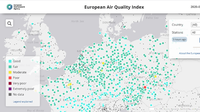
NEW MOBILE APP AVAILABLE FOR DOWNLOAD --- How clean is the air you’re breathing right now? How does the air in your city compare with that of a neighbouring city or region?
Air pollution is the single largest environmental health risk in Europe. The European Environment Agency's European Air Quality Index allows users to understand more about air quality where they live. Displaying up-to-the-minute data for the whole of Europe, users can gain new insights into the air quality of individual countries, regions and cities.

The CORINE Land Cover (CLC) inventory was initiated in 1985 (reference year 1990) to standardize data collection on land in Europe to support environmental policy development. Updates were produced in 2000, 2006, 2012 and 2018. Change layers were produced for 2000, 2006, 2012 and 2018.














Directive 2009/28/EC on the promotion and use of energy from renewable sources commits the EU to achieving a 20 % share of renewable energy sources (RES) in its gross final energy consumption by 2020 and a 10 % share of renewable energy in transport energy consumption by the same year. Article 22 of the directive requires Member States to report on national progress in the promotion and use of energy from renewable sources, biennially, starting with 31 December 2011. It specifies that the national reports shall contain, inter alia, the estimated net GHG emission savings due to the use of energy from renewable sources.
Information regarding the specific methodologies used by the countries for producing the above estimates of net GHG emission savings is not always available. To that end, the EEA and its European Topic Centre for Air Pollution and Climate Change Mitigation (ETC/ACM) produce each year a consistent set of estimated co-benefits, at the Member State and EU level, concerning the impact on fossil fuels and GHG emissions due to the increase in RES consumption since 2005. For 2017, these estimated co-benefits are based on the EEA 2017 RES share proxies and the EEA 2017 proxies on primary and final energy consumption.

Indexed SO2, NOx and dust emissions from electricity generation for 2004 to 2015

The three graphs show the progression of emission limits in EU industrial emission policy over time. The example chosen is that emission limits for SO2, NOx and dust from existing large coal fired power plants.

The three graphs show the progression of total SO2, NOx and dust emissions between 2016 and 2030 given 3 different scenarios: if current IED emission limits are applied, if only the upper emission limits of new requirements are implemented or if implementation is strictly according to the lower emission limits of new requirements.